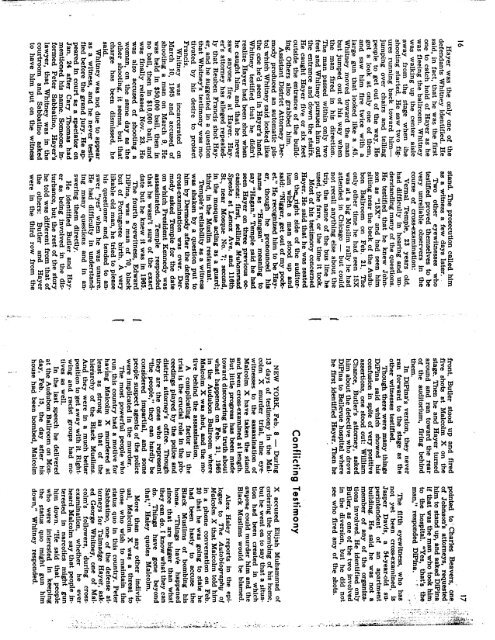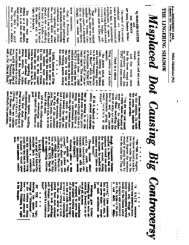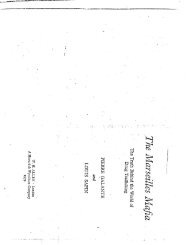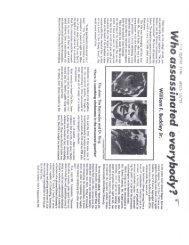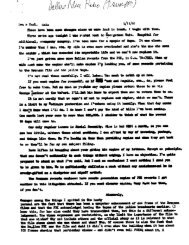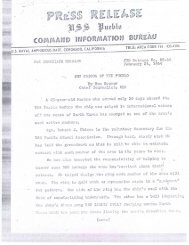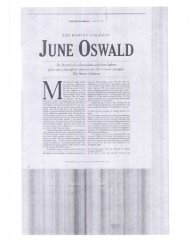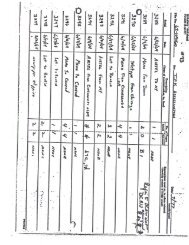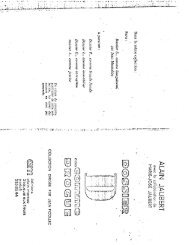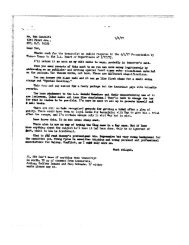THE ASSASSINATION OF MALCOLM X
THE ASSASSINATION OF MALCOLM X
THE ASSASSINATION OF MALCOLM X
You also want an ePaper? Increase the reach of your titles
YUMPU automatically turns print PDFs into web optimized ePapers that Google loves.
16<br />
Hayer was the only one of the<br />
defendants Whitney identified. He<br />
said, in fact, that he was the first<br />
one to catch hold of Hayer as he<br />
was fleeing the ballroom. Whitney<br />
was walking up the center aisle<br />
away from the stage when the<br />
shooting started. He saw two figures<br />
running back toward him—<br />
jumping over chairs and telling<br />
people to get out of the way. He<br />
got a look at only one of them,<br />
and saw him fire twice with a<br />
large gun that looked like a .45.<br />
Whitney moved toward the man<br />
but jumped out of his way when<br />
the man fired in his direction.<br />
The man passed within only two<br />
feet and Whitney pursued him out<br />
the entrance and down the staffs.<br />
He caught Hayer five or six feet<br />
outside the entrance of the building.<br />
Others also grabbed him.<br />
Assistant District Attorney Dermody<br />
produced an automatic pistol<br />
which Whitney said looked like<br />
the one he'd seen in Hayer's hand.<br />
Whitney testified that he didn't<br />
realize Hayer had been shot when<br />
he caught him, and that he never<br />
saw anyone fire at Hayer. Hayer's<br />
attorney has alleged repeatedly<br />
that Reuben Francis shot Hayer,<br />
and he Suggested in a question<br />
that Whitney's testimony was motivated<br />
by his desire to protect<br />
Francis.<br />
Whitney was incarcerated on<br />
March 10, 1965 and accused of<br />
shooting a man on March 9. He<br />
was held in $50,000 bail, then in<br />
no bail, then in $10,000 bail, and<br />
was finally released Nov. 23. He<br />
was also accused of shooting a<br />
woman, on the same day as the<br />
other shooting, it seems, but that<br />
charge has been dismissed, he<br />
said.<br />
Whitney was not due to appear<br />
as a witness, and he never testiw<br />
fled before the grand jury. He appeared<br />
in court as a spectator on<br />
Jan. 24 after Cary Thomas had<br />
mentioned his name. Someone informed<br />
Peter Sabbatino, Hayer's<br />
lawyer, that Whitney was in the<br />
courtroom and Sabbatino asked<br />
to have him put on the witness<br />
stand. The prosecution called him<br />
as a witness a few days later.<br />
Two other eyewitnesses who<br />
testified proved themselves to be<br />
very unreliable observers in the<br />
course of cross-examination:<br />
Vernal Temple, 23 years old,<br />
had difficulty in hearing and understanding<br />
many of the questions.<br />
He testified that he knew Johnson<br />
as "15X" and had seen him<br />
sitting near the back of the Audubon<br />
Ballroom on Feb. 21. The<br />
only other time he had seen 15X<br />
was at a big Muslim rally he had<br />
attended in Chicago — but could<br />
not recall anything else about the<br />
trip, the name of the bus line he<br />
used, the fare, or the time it took.<br />
Most of his testimony concerned<br />
Hayer. He said that he was seated<br />
on the,,,right side of the auditorium<br />
when a man stood up and<br />
said: "Nigger, get out of my pocket."<br />
He recognized him to be Hayer,<br />
though he pronounced his<br />
name as "Hangan" meaning to<br />
say "Hagan." Temple said he had<br />
seen Hayer on three previous occasions:<br />
first, selling Muhammad<br />
Speaks at Lenox Ave. and 116th<br />
St., near Mosque No. 7; second,<br />
in the mosque acting as a guard;<br />
third, in the Muslim restaurant.<br />
Temple's reliability as a witness<br />
was shaken by a question put to<br />
him by Dermody after the defense<br />
cross-examination was over. Dermody<br />
asked Temple for the date<br />
on which President Kennedy was<br />
assassinated. Temple responded<br />
that he wasn't sure of the exact<br />
date but he knew it was in 1965.<br />
The fourth eyewitness, Edward<br />
DiPina, was a man of 70, black<br />
but of Portuguese birth. A very<br />
likable old man, he tried to please<br />
his questioner and tended to answer<br />
"yes" when he was unsure.<br />
He had difficulty in understanding<br />
many questions and in answering<br />
them directly.<br />
He identified Butler and Hayer<br />
as being involved in the disturbance,<br />
but the rest of the story<br />
he told was different from that of<br />
the others: Butler and Hayer<br />
were in the third row from the<br />
NEW YORK, Feb. 8 — During<br />
13 days of testimony in the Malcolm<br />
X murder trial, nine eyewitnesses<br />
to the assassination of<br />
Malcolm X have taken the stand<br />
and been cross-examined at length.<br />
But little progress has been made<br />
toward discovering the truth about<br />
what happened on Feb. 21, 1965<br />
in the Audubon Ballroom where<br />
• Malcolm X was shot, and the motive<br />
behind the assassination.<br />
A complicating factor in the<br />
trial is the crucial role in the pioceedings<br />
played by the police and<br />
district attorney's office. Though<br />
they are the ones who represent<br />
"the people," they can hardly be<br />
considered impartial, and some<br />
people suspect agents of the police<br />
were implicated in the murder.<br />
The most powerful people who<br />
run,this country had a motive for<br />
having Malcolm X murdered at<br />
least as strong as that of the<br />
hierarchy of the Black Muslims.<br />
And they were in a much better<br />
position to get away with it. Rightwing<br />
and racist groups had motives<br />
as well.<br />
In the last speech he delivered<br />
at the Audubon Ballroom on Monday,<br />
Feb. 15, the day after his<br />
house had been bombed, Malcolm<br />
X accused Elijah Muhammad of<br />
ordering the bombing of his home,<br />
but he went on to say that a situation<br />
had been created in which<br />
anyone could murder him and the<br />
Black Muslims would be blamed.<br />
Alex Haley reports in the epilogue<br />
to The Autobiography of<br />
Malcolm X that Malcolm told him<br />
in a phone conversation on Feb.<br />
20 that he was going to state he<br />
had been hasty to accuse the<br />
Black Muslims of bombing his<br />
home. "Things haVe happened<br />
since that are bigger than What<br />
they can do. I know what they can<br />
do. Things have gone beyond<br />
that," Haley quotes Malcolm.<br />
More than any other individual,<br />
Malcolm X was a threat to<br />
those who wish to maintain the<br />
status quo in this country. Peter<br />
Sabbatino, one of the defense attorneys<br />
for Talmadge Bayer, asked<br />
George Whitney, one of Malcolm's<br />
followers, during crossexamination,<br />
whether he ever<br />
heard Malcolm say that people interested<br />
in narcotics might gun<br />
him down. "He said that people<br />
who were interested in keeping<br />
the status quo might gun him<br />
down," Whitney responded.<br />
Conflicting Testimony<br />
front. Butler stood up and fired<br />
five shots at Malcolm X on the<br />
stage. Then he and Hayer turned<br />
around and ran toward the rear<br />
of the auditorium, firing behind<br />
them.<br />
In DiPina's version, they never<br />
ran forward to the stage as the<br />
other witnesses testified.<br />
Though there were many things<br />
DiPina said which showed his<br />
confusion in spite of very positive<br />
assertions, one stood out: William<br />
Chance, Butler's attorney, asked<br />
him about the detective who drove<br />
DiPina to Bellevue hospital where<br />
he first identified Hayer. Then he<br />
The fifth eyewitness, who has<br />
not yet been cross-examined, is<br />
Jasper Davis, a 54-year-old superintendent<br />
of an apartment<br />
building. He said he was not a<br />
member of any of the organizations<br />
involved. He identified only<br />
Butler, as one of the two involved<br />
in the diversion, but he did not<br />
see who fired any of the shots.<br />
17<br />
pointed to Charles Beavers, one,<br />
of Johnson's attorneys, requested<br />
him to stand up, and asked DiPina<br />
if that was the man who took hirn<br />
to the hospital. "Yes that's the<br />
man," responded DiPine.


